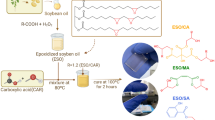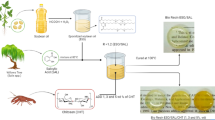Abstract
This work highlights the importance of renewable materials, specifically polymers derived from epoxidized oils, in promoting sustainable development and reducing the environmental impact of various industries. The use of carboxylic acids as hardeners for biobased resins from epoxidized oils is also discussed as a promising development in this field. However, there is a lack of research in this area, and finding the right combination of carboxylic acids and epoxidized oils remains a challenge. The present work aimed to address this gap by synthesizing biobased resins using epoxidized soybean oil (ESO) and dicarboxylic acids with specific aliphatic chain lengths, such as oxalic, succinic, adipic and sebacic acids with 0, 2, 4 and 8 carbons in aliphatic chain. The curing and properties of the resulting biopolymers were investigated using DSC, FTIR, TGA, and swelling ratio assessments. FTIR spectra evidenced that the reaction between epoxy and carboxylic groups occurred by the presence of ester groups, as verified after the disappearance of the epoxy bands at ~ 829 cm−1 and the appearance of related bands to hydroxyl (-OH) at ~ 3500 and ester at 1685–1742 cm−1, respectively. DSC scans presented exothermic peaks related to the curing reactions associated to an increasing enthalpy (ΔH) as the aliphatic chain size increases. The activation energy, Eac, estimated using Friedman and Vyazovkin approaches, is highly influenced by the chain size and pKa of the acids. Furthermore, the thermal and hydrocatalytic degradation increase with the decrease of aliphatic chain. The study also introduces oxalic acid as a biobased cross linker for ESO, which has not been so far combined without any synthetic modifications in its structure.









Similar content being viewed by others

References
Abdelwahab MA, Misra M, Mohanty AK (2015) Epoxidized pine oil-siloxane: crosslinking kinetic study and thermomechanical properties. J Appl Polym Sci 132:1–12. https://doi.org/10.1002/app.42451
Alarcon RT, Lamb KJ, Bannach G, North M (2021) Opportunities for the use of brazilian biomass to produce renewable chemicals and materials. Chemsuschem 14:169–188. https://doi.org/10.1002/cssc.202001726
Altuna FI, Hoppe CE, Williams RJJ (2018) Epoxy vitrimers: The effect of transesterification reactions on the network structure. Polymers (Basel). https://doi.org/10.3390/polym10010043
Bechthold I, Bretz K, Kabasci S, Kopitzky R, Springer A (2008) Succinic acid: a new platform chemical for biobased polymers from renewable resources. Chem Eng Technol. https://doi.org/10.1002/ceat.200800063
Boyer A, Cloutet E, Tassaing T, Gadenne B, Alfos C, Cramail H (2010) Solubility in CO2 and carbonation studies of epoxidized fatty acid diesters: Towards novel precursors for polyurethane synthesis. Green Chem 12:2205–2213. https://doi.org/10.1039/c0gc00371a
Chen X, Chen S, Xu Z, Zhang J, Miao M, Zhang D (2020) Degradable and recyclable bio-based thermoset epoxy resins. Green Chem 22:4187–4198. https://doi.org/10.1039/d0gc01250e
Chrissafis K, Paraskevopoulos KM, Bikiaris DN (2006) Thermal degradation kinetics of the biodegradable aliphatic polyester, poly(propylene succinate). Polym Degrad Stab 91:60–68. https://doi.org/10.1016/j.polymdegradstab.2005.04.028
Ciannamea EM, Ruseckaite RA (2018) Pressure sensitive adhesives based on epoxidized soybean oil: correlation between curing conditions and rheological properties. J Am Oil Chem Soc 95:525–532. https://doi.org/10.1002/AOCS.12046
Di Mauro C, Malburet S, Genua A, Graillot A, Mija A (2020) Sustainable series of new epoxidized vegetable oil-based thermosets with chemical recycling properties. Biomacromol 21:3923–3935. https://doi.org/10.1021/acs.biomac.0c01059
Ding C, Matharu AS (2014) Recent developments on biobased curing agents: a review of their preparation and use. ACS Sustain Chem Eng 2:2217–2236. https://doi.org/10.1021/sc500478f
Ding C, Shuttleworth PS, Makin S, Clark JH, Matharu AS (2015) New insights into the curing of epoxidized linseed oil with dicarboxylic acids. Green Chem 17:4000–4008. https://doi.org/10.1039/c5gc00912j
Falco G, Sbirrazzuoli N, Mija A (2019) Biomass derived epoxy systems: From reactivity to final properties. Mater. Today Commun. 21:100683. https://doi.org/10.1016/j.mtcomm.2019.100683
Flory PJ (1953) Principles of polymer chemistry. Cornell University Press
Frias CF, Serra AC, Ramalho A, Coelho JFJ, Fonseca AC (2017) Preparation of fully biobased epoxy resins from soybean oil based amine hardeners. Ind Crops Prod 109:434–444. https://doi.org/10.1016/j.indcrop.2017.08.041
Friedman HL (1967) Kinetics and Gaseous Products of Thermal Decomposition of Polymers. J Macromol Sci Part A - Chem 1:57–79. https://doi.org/10.1080/10601326708053917
Gobin M, Loulergue P, Audic JL, Lemiègre L (2015) Synthesis and characterisation of bio-based polyester materials from vegetable oil and short to long chain dicarboxylic acids. Ind Crops Prod 70:213–220. https://doi.org/10.1016/j.indcrop.2015.03.041
Gogoi P, Horo H, Khannam M, Dolui SK (2015) In situ synthesis of green bionanocomposites based on aqueous citric acid cured epoxidized soybean oil-carboxylic acid functionalized multiwalled carbon nanotubes. Ind Crops Prod 76:346–354. https://doi.org/10.1016/j.indcrop.2015.06.057
Hu F, La Scala JJ, Yadav SK, Throckmorton J, Palmese GR (2021) Epoxidized soybean oil modified using fatty acids as tougheners for thermosetting epoxy resins: part 2—effect of curing agent and epoxy molecular weight. J Appl Polym Sci 138:50579. https://doi.org/10.1002/app.50579
Hu F, La Scala JJ, Yadav SK, Throckmorton J, Palmese GR, La Scala JJ, Throckmorton J, Palmese GR (2021) Epoxidized soybean oil modified using fatty acids as tougheners for thermosetting epoxy resins: part 2—effect of curing agent and epoxy molecular weight. J Appl Polym Sci 138:50570. https://doi.org/10.1002/app.50579
Jansen MLA, van Gulik WM (2014) Towards large scale fermentative production of succinic acid. Curr Opin Biotechnol. https://doi.org/10.1016/j.copbio.2014.07.003
Kulkarni MV, Viswanath AK (2004) Comparative studies of chemically synthesized polyaniline and poly(o-toluidine) doped with p-toluene sulphonic acid. Eur Polym J 40:379–384. https://doi.org/10.1016/j.eurpolymj.2003.10.007
Kumar S, Krishnan S, Samal SK, Mohanty S, Nayak SK (2018) Toughening of petroleum based (DGEBA) epoxy resins with various renewable resources based flexible chains for high performance applications: a review. Ind Eng Chem Res 57:2711–2726. https://doi.org/10.1021/acs.iecr.7b04495
Lei YF, Wang XL, Liu BW, Ding XM, Chen L, Wang YZ (2020) Fully bio-based pressure-sensitive adhesives with high adhesivity derived from epoxidized soybean oil and rosin acid. ACS Sustain Chem Eng 8:13261–13270. https://doi.org/10.1021/acssuschemeng.0c03451
Li YD, Jian XY, Zhu J, Du AK, Zeng JB (2018) Fully biobased and high performance epoxy thermosets from epoxidized soybean oil and diamino terminated polyamide 1010 oligomers. Polym Test 72:140–146. https://doi.org/10.1016/j.polymertesting.2018.10.010
Liu J, Zhang L, Shun W, Dai J, Peng Y, Liu X (2021) Recent development on bio-based thermosetting resins. J Polym Sci. https://doi.org/10.1002/pol.20210328
Manthey NW (2013). Development of hemp oil based bioresins for biocomposites. Fac. Eng. Surv. Doctor of.
Mashouf Roudsari G, Mohanty AK, Misra M (2014) Study of the curing kinetics of epoxy resins with biobased hardener and epoxidized soybean oil. ACS Sustain Chem Eng 2:2111–2116. https://doi.org/10.1021/SC500176Z/ASSET/IMAGES/LARGE/SC-2014-00176Z_0008.JPEG
Omonov TS, Curtis JM (2015) Plant Oil-Based Epoxy Intermediates for Polymers, Bio-based Plant Oil Polymers and Composites. Elsevier Inc., Netherlands. https://doi.org/10.1016/B978-0-323-35833-0.00007-4
PANSUMDAENG, J., Kuntharin, S., Harnchana, V., Supanchaiyamat, N., (2020) Fully bio-based epoxidized soybean oil thermosets for high performance triboelectric nanogenerators. Green Chem 22:6912–6921. https://doi.org/10.1039/d0gc01738h
Parada Hernandez NL, Bahú JO, Schiavon MIRB, Bonon AJ, Benites CI, Jardini AL, Maciel Filho R, Wolf Maciel MRW (2019) (Epoxidized castor oil – citric acid) copolyester as a candidate polymer for biomedical applications. J Polym Res. https://doi.org/10.1007/s10965-019-1814-5
Poutrel QA, Blaker JJ, Soutis C, Tournilhac F, Gresil M (2020) Dicarboxylic acid-epoxy vitrimers: Influence of the off-stoichiometric acid content on cure reactions and thermo-mechanical properties. Polym Chem 11:5327–5338. https://doi.org/10.1039/d0py00342e
Qi M, Xu YJ, Rao WH, Luo X, Chen L, Wang YZ (2018) Epoxidized soybean oil cured with tannic acid for fully bio-based epoxy resin. RSC Adv 8:26948–26958. https://doi.org/10.1039/c8ra03874k
Sahoo SK (2018) Development of completely bio - based epoxy networks derived from epoxidized linseed and castor oil cured with citric acid. Polym Adv Technol. https://doi.org/10.1002/pat.4316
Sivanesan D, Seo BK, Lim CS, Kim S, Kim HG (2021) Trifunctional cycloaliphatic epoxy-based thermoset polymers: Synthesis, polymerization, and characterization. Polymer (Guildf). 220:123568. https://doi.org/10.1016/j.polymer.2021.123568
Song H, Lee SY (2006) Production of succinic acid by bacterial fermentation. Enzyme Microb Technol. https://doi.org/10.1016/j.enzmictec.2005.11.043
Tan SG, Chow WS (2010) Biobased epoxidized vegetable oils and its greener epoxy blends: a review. Polym - Plast Technol Eng. https://doi.org/10.1080/03602559.2010.512338
Tellers J, Jamali M, Willems P, Tjeerdsma B, Sbirrazzuoli N, Guigo N (2021) Cross-linking behavior of eutectic hardeners from natural acid mixtures. Green Chem 23:536–545. https://doi.org/10.1039/d0gc03172k
Tran TN, Di Mauro C, Graillot A, Mija A (2020) Chemical reactivity and the influence of initiators on the Epoxidized Vegetable Oil/Dicarboxylic acid system. Macromolecules 53:2526–2538. https://doi.org/10.1021/acs.macromol.9b02700
Treloar LRG (1975) The physics of rubber elasticity.
Vidil T, Tournilhac F, Musso S, Robisson A, Leibler L (2016) Control of reactions and network structures of epoxy thermosets. Prog Polym Sci 62:126–179. https://doi.org/10.1016/j.progpolymsci.2016.06.003
Vyazovkin S, Burnham AK, Criado JM, Pérez-Maqueda LA, Popescu C, Sbirrazzuoli N (2011) ICTAC Kinetics Committee recommendations for performing kinetic computations on thermal analysis data. Thermochim Acta. https://doi.org/10.1016/j.tca.2011.03.034
Waig Fang S, De Caro P, Pennarun PY, Vaca-Garcia C, Thiebaud-Roux S (2013) Synthesis and characterization of new polyesters based on renewable resources. Ind Crops Prod 43:398–404. https://doi.org/10.1016/j.indcrop.2012.07.027
Wu J, Zhao C, Li Y, Li H, Xiang D, Sun Z, Li X (2021) Properties of bio-based thermosetting composites synthesized from epoxidized soybean oil and azo-cardanol benzoxazine. J Polym Res. https://doi.org/10.1007/s10965-021-02442-z
Yadav GG, David A, Favaloro T, Yang H, Shakouri A, Caruthers J, Wu Y (2013) Synthesis and investigation of thermoelectric and electrochemical properties of porous Ca9Co12O28 nanowires. J Mater Chem A 1:11901–11908. https://doi.org/10.1039/c3ta12096a
Zeng R, Wu Y, Li Y, Wang M, Zeng J (2017) Curing behavior of epoxidized soybean oil with biobased dicarboxylic acids. Polym Test 57:281–287. https://doi.org/10.1016/j.polymertesting.2016.12.007
Zhang C, Li Y, Chen R, Kessler MR (2014) Polyurethanes from solvent-free vegetable oil-based polyols. ACS Sustain Chem Eng 2:2465–2476. https://doi.org/10.1021/SC500509H/ASSET/IMAGES/MEDIUM/SC-2014-00509H_0007.GIF
Acknowledgements
The author would thank BBC Química – São Paulo, Brazil for kindly providing the epoxidized soybean oil (ESO). Authors are gratefully to CERTBIO (Northeast Biomaterials Evaluation and Development Laboratory—Brazil) for the supported infrastructure.
Funding
The authors are grateful to CNPq (National Council for Scientific and Technological Development, Brasilia/DF, Brazil) for the financial support. Fundação de Apoio à Pesquisa do Estado da Paraíba (FAPESQ) (Concession term: 022/2023). Professor Renate Wellen is CNPq fellow (Number: 303426/2021-7).
Author information
Authors and Affiliations
Contributions
All authors contributed to the data acquisition, writing and revision of the paper
Corresponding author
Ethics declarations
Conflict of Interest
There is no conflict of interest and all authors have agreed with this submission and they are aware of the content.
Additional information
Publisher's Note
Springer Nature remains neutral with regard to jurisdictional claims in published maps and institutional affiliations.
Supplementary Information
Below is the link to the electronic supplementary material.
Rights and permissions
Springer Nature or its licensor (e.g. a society or other partner) holds exclusive rights to this article under a publishing agreement with the author(s) or other rightsholder(s); author self-archiving of the accepted manuscript version of this article is solely governed by the terms of such publishing agreement and applicable law.
About this article
Cite this article
Nepomuceno, N.C., Barreto, V. & Wellen, R.M.R. Effect of Dicarboxylic Acids’ Aliphatic Chain on the Curing of Epoxidized Soybean Oil (ESO) Resins. J Polym Environ 32, 45–56 (2024). https://doi.org/10.1007/s10924-023-02958-z
Accepted:
Published:
Issue Date:
DOI: https://doi.org/10.1007/s10924-023-02958-z



